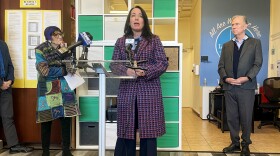Oluwaseyi Oluborode is going into her senior year at University High School of Science and Engineering (UHSSE), a STEM magnet school in Hartford. With the help of a free bus fare program at her school, she's able to go to the library to work on school assignments, participate in community organizations like the Hartford-based advocacy group Speak Up and take part in social activities with her peers.
“College is approaching, and it's really important that I demonstrate that I'm engaged in my school and in extracurriculars,” Oluborode said. “It's really hard for you to have a leadership position in a club or to have an impact within your community if you aren't able to frequently attend meetings.”
It can cost up to $3.50 for Oluborode to get a full-day city bus pass. That bus fare on a daily basis can add up which, Oluborode said, is something many of her peers can't afford.
A pilot free bus fare program at her school, however, has allowed her to be able to commit to more extracurricular activities, she said.
“It's definitely made things easier because I don't feel like I'm a burden to my parents,” Oluborode said. “I also feel like I have autonomy. It feels empowering, knowing that you can get where you want, where you need to go, and there isn't that hassle [of going] back and forth.”
That program may not be coming back next school year due to a lack of funding. Oluborode is worried that her future may be negatively impacted without that access to transportation.
“I feel like it would undermine my college application, if I would have to drop all the extracurriculars I had been partaking in all throughout high school,” she said.
Oluborode is one of several students in the Social Justice League at her school fighting to keep the free bus fare service alive, asking legislators to not forget about them as community members across the state are calling for more funding in the state budget for education.

The mission of the Social Justice League
When a pandemic-era program that provided free fare for bus riders ended in April 2023, UHSSE principal Sean Tomany scrambled to get free bus passes for his students for the rest of the school year. That’s because earlier in the year, Tomany said he learned the importance of access to bus transportation after speaking with a student.
The student, Juan Cruz, came late to school one February morning. Tomany said he explained that he was late because the bus was too full.
“It dawns on me, he's a walker. He lives 1.8 miles away,” Tomany said. “At that moment, and it's embarrassing, as an educator who's worked in Hartford for 25 years, that I never saw how much transportation impacts so many of my kids.”
High school students in Hartford are eligible for school bus transportation to and from school if they live two miles or more from their school. But for students like Cruz, Tomany said they either have to walk or take the city bus.
“He gets out of bed and comes to school because he wants to,” Tomany said. “I don't think you're gonna find an adult that wants to walk 1.8 miles in two degree weather.”
So Tomany created a club with some of his students called the Social Justice League to advocate for free bus passes for students. Last year, they helped establish the pilot free bus fare program for students in Hartford and New Haven.
According to Tomany, he was able to buy 500 students bus passes for 10 months with the $175,000 that was allocated for the Hartford program.
As part of the program, Tomany surveyed the students who participated. Across the high schools that participated, including UHSSE, Weaver High School and Hartford High School, nearly half of students reported the city bus was the main transportation option for their family. 45% said their family shared one car.
Having that access to transportation allows students to attend to school, Tomany said, which addresses the issue of chronic absenteeism that schools have been struggling with since the pandemic. Take medical appointments, for example.
“The kid has a doctor's appointment, he misses a whole day of school, whereas now they have a bus pass, so they get on the bus, they go to the doctor's appointment, and then they come to school,” Tomany said.
Attendance is just one part of it, however. Tomany said it helps students grow as individuals. One student, he said, was even able to start a savings account.
“She got a job because she has a bus pass. She used that bus pass to save up money. She bought a car and now she's going to prom because she has the money, because she has a bus pass, because she has a job,” Tomany said.
Most students, according to the survey, used their bus pass to participate in sport or community programs, to support family or to partake in social activities.
Most importantly, Tomany argued, is the fact that access to transportation allows students to stay connected to their school and community.
“You know why kids come to school? They have relationships with the adults in the building. How do you develop those relationships? You play a sport, you join a club, you just hang out with Mr. Tomany at three o'clock because you can, because you can catch the bus down at Annie Fisher at 3:40,” Tomany said. “That is the power of what this can do.”

Students call on legislature to step up
Nayeli Figueroa is a junior at UHSSE and a member of the Social Justice League. Now that the pilot program has run out of funding, she’s called on the legislature with her fellow club members to keep the program going with a bill that would provide fare-free bus public transportation services for high school students and veterans.
“I feel very strong as a young Latina woman in Connecticut,” Figueroa said. “You know, these challenges are hard, and a lot of people tend to forget about us kids of minorities.”
Figueroa said she would often have to search the car, couch or laundry machine for loose change around the house to be able to get $1.75 for a two-hour bus pass.
“You think it's a small amount to pay, but it definitely adds up long term,” she said.
With the free bus fare program, she said she was able to gain independence to learn and grow outside the classroom.
“I was able to get a lifeguard certification,” Figueroa said. “I took different classes, and with the bus pass, I was able to get there, and I was also able to, once I got out, go straight to work.”
Without it, she said it would be a major hindrance.
“I feel like I would go back to my freshman and sophomore year, where I was very limited to resources,” Figueroa said. “I feel like I would take some steps back in life.”
With legislators working to get more funding in the state budget for education, including special education, it’s unclear if the free bus fare bill will pass this legislative session.
Whether the bill passes or not, Figueroa said she won’t stop advocating for free bus passes for urban students.
“I think this is something that should be solidified within Hartford Public Schools and statewide,” she said, “because we are silently excluding so many students when we don't recognize this need.”
Learn more
Hear more about the Social Justice League's push for expanded access to transportation on CT Public's "Disrupted" with host Khalilah Brown-Dean.
Correction: This story has been updated to clarify that many of Oluborode’s peers can’t afford bus fare, and to clarify she also uses the bus fare to socialize with friends from school.





